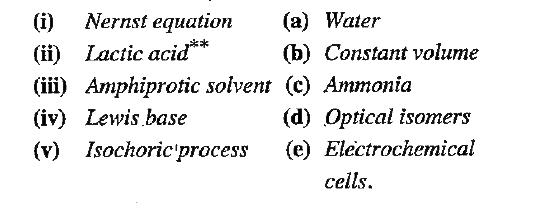Which of the following molecule has same dipole moment :-


PF3Cl2
All
The correct Answer is:D
To determine which of the given molecules has the same dipole moment, we will analyze the dipole moments of each molecule step by step.
Step 1: Understand Dipole Moment
The dipole moment is a vector quantity that depends on the magnitude of the charge and the distance between the charges. It is represented as μ=q⋅r, where q is the charge and r is the distance between the charges. In molecules, the dipole moment arises due to the difference in electronegativity between atoms.
Hint: Remember that dipole moments can cancel out if the molecular geometry is symmetrical.
Step 2: Analyze Paracresol
Paracresol has a benzene ring with an -OH group. The -OH group can be positioned in two ways: cis and trans.
- In the trans configuration, the dipole moments from the -OH groups cancel each other out due to symmetry, resulting in a net dipole moment of 0.
- In the cis configuration, the dipole moments do not cancel out and result in a net dipole moment of approximately 2.25 D.
Hint: Check the symmetry of the molecule to determine if the dipole moments cancel.
Step 3: Analyze Methoxybenzene
Methoxybenzene (or anisole) also has a benzene ring with an -OCH3 group. Similar to paracresol:
- In the trans configuration, the dipole moments cancel out, resulting in a net dipole moment of 0.
- In the cis configuration, the dipole moments do not cancel and yield a net dipole moment of approximately 2.26 D.
Hint: Compare the configurations of methoxybenzene to paracresol to see if they behave similarly.
Step 4: Analyze PF3Cl2
PF3Cl2 has a phosphorus atom bonded to three fluorine atoms and two chlorine atoms. The geometry is trigonal bipyramidal (sp3d hybridization).
- The three fluorine atoms are more electronegative than the two chlorine atoms. The dipole moments from the fluorine atoms do not cancel out completely due to the presence of chlorine atoms, leading to a net dipole moment that is not zero.
Hint: Consider the electronegativity of the atoms and the molecular geometry to determine the resultant dipole moment.
Step 5: Conclusion
From the analysis:
- Paracresol (cis) and Methoxybenzene (cis) both have similar configurations leading to similar dipole moments (approximately 2.25 D and 2.26 D respectively).
- PF3Cl2 has a different dipole moment due to its asymmetrical structure.
Thus, the molecules that have the same dipole moment are Paracresol (cis) and Methoxybenzene (cis).
Final Answer: The molecules with the same dipole moment are A (Paracresol) and B (Methoxybenzene).
The dipole moment is a vector quantity that depends on the magnitude of the charge and the distance between the charges. It is represented as μ=q⋅r, where q is the charge and r is the distance between the charges. In molecules, the dipole moment arises due to the difference in electronegativity between atoms.
Paracresol has a benzene ring with an -OH group. The -OH group can be positioned in two ways: cis and trans.
- In the cis configuration, the dipole moments do not cancel out and result in a net dipole moment of approximately 2.25 D.
Methoxybenzene (or anisole) also has a benzene ring with an -OCH3 group. Similar to paracresol:
- In the cis configuration, the dipole moments do not cancel and yield a net dipole moment of approximately 2.26 D.
PF3Cl2 has a phosphorus atom bonded to three fluorine atoms and two chlorine atoms. The geometry is trigonal bipyramidal (sp3d hybridization).
From the analysis:
- Paracresol (cis) and Methoxybenzene (cis) both have similar configurations leading to similar dipole moments (approximately 2.25 D and 2.26 D respectively).
- PF3Cl2 has a different dipole moment due to its asymmetrical structure.
Topper's Solved these Questions
- INORGANIC CHEMISTRYBOOK - ALLENCHAPTER - INORGANIC CHEMISTRYEXERCISE - COORDINATION COMPOUNDS & d-BLOCK COMPOUNDS
109 Videos
- INORGANIC CHEMISTRYBOOK - ALLENCHAPTER - INORGANIC CHEMISTRYEXERCISE - COORDINATION COMPOUNDS & d-BLOCK COMPOUNDS (MATCH THE COLUMN)
2 Videos
- INORGANIC CHEMISTRYBOOK - ALLENCHAPTER - INORGANIC CHEMISTRYEXERCISE - PERIODIC TABLE (MATCH THE COLUMN TYPE QUESTIONS)
5 Videos
- HYDROGENBOOK - ALLENCHAPTER - HYDROGENEXERCISE - EXERCISE-5
17 Videos
- Ionic EquilibriumBOOK - ALLENCHAPTER - Ionic EquilibriumEXERCISE - All Questions
37 Videos
Similar Questions
Knowledge Check
Match the following:
 AA and DBB and CCC and EDB and E
AA and DBB and CCC and EDB and EWhich of the following molecules has highest dipole moment?
ACH3ClBCH2Cl2CCHCl3DCCl4Which of the following molecules has the maximum dipole moment?
ACO2BCH4CNH3DNF3
Which of the following molecule has highest dipole moment?
View SolutionWhich of the following molecule has highest dipole moment?
View SolutionWhich of the following pairs have same dipole moment
View SolutionWhich of the following molecules has the maximum dipole moment ?
View SolutionWhich of the following compound has least dipole moment ?
View Solution
